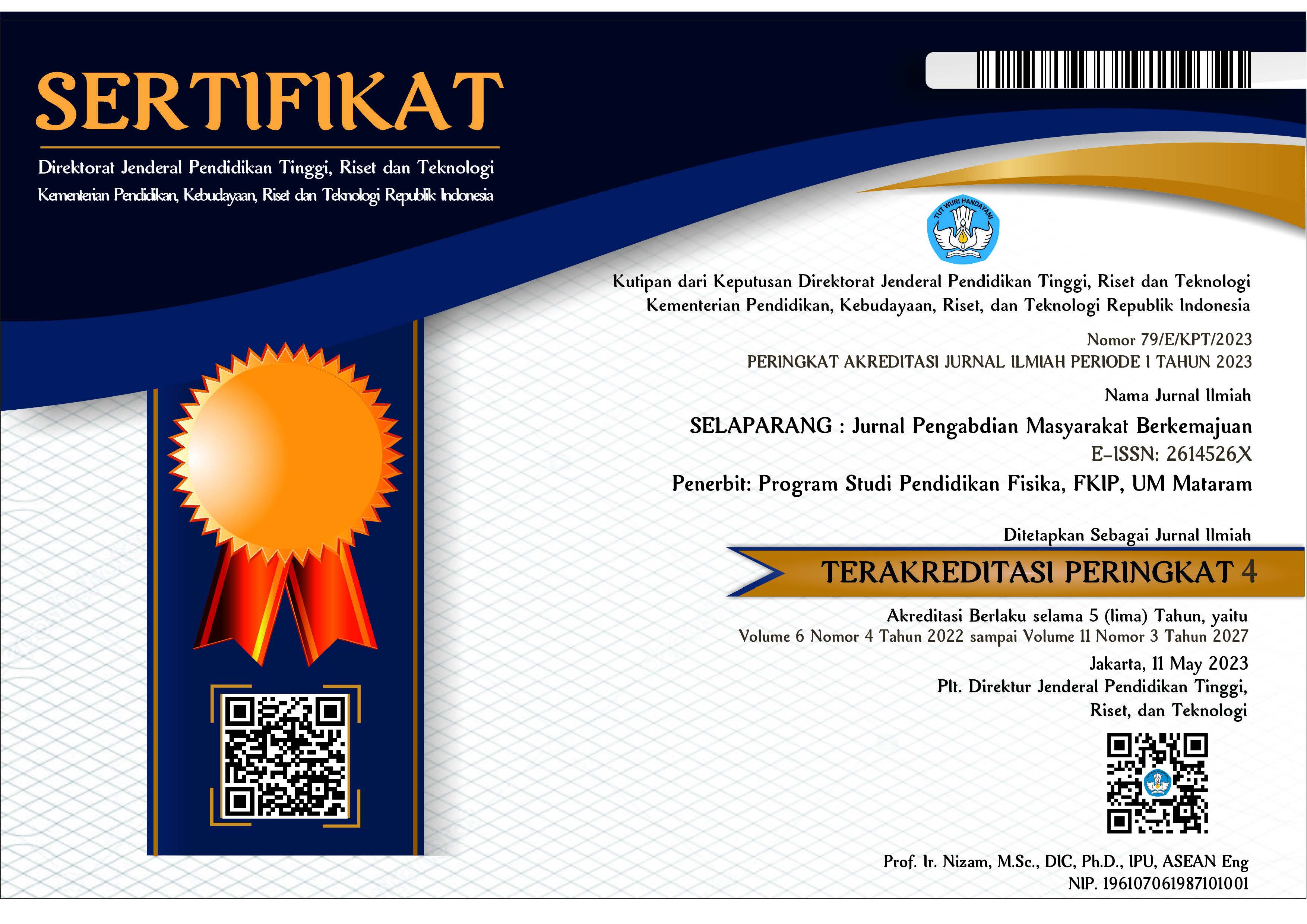PENGGUNAAN AGEN HAYATI Trichoderma Sp. UNTUK PENGENDALIAN HAMA PENYAKIT PADA TANAMAN PERTANIAN MILIK PETANI DI DESA KENOKOREJO, POLOKARTO, SUKOHARJO
Abstract
ABSTRAK
Trichoderma sp. merupakan jenis jamur yang umumnya banyak ditemui di area tanah khususnya tanah yang memiliki kandungan bahan organik yang cukup tinggi sehinga dapat membantu pertumbuhan tanaman. Pembuatan agen hayati dari jenis Trichoderma sp. sebagai agen pengendali hama tanaman telah dilaksanakan di kelompok tani SERUT, Desa Kenokorejo Kecamatan Polokarto Kabupaten Sukoharjo. Biakan agen hayati Trichoderma sp. diperbanyak melalui media beras kukus, hal ini bertujuan agar petani mampu membuat agen hayati Trichoderma sp. sendiri dengan bahan dasar yang selalu ada di lingkungan petani. Pengabdian kepada masyarakat ini bertujuan untuk memberikan pengetahuan kepada petani tentang manfaat jamur Trichoderma sp. sebagai agen hayati yang murah dan ramah lingkungan serta cara pengaplikasiannya pada tanaman. Hasil pengabdian kepada masyarakat ini menunjukkan bahwa petani di kelompok tani SERUT menerima dengan baik cara membuat biakan Trichoderma sp dan mampu memperbanyak biakan Trichoderma sp. serta mengaplikasikannnya pada tanaman padi di lahan sawahnya.
Kata kunci: Trichoderma sp. agen hayati; bahan organik
ABSTRACT
Trichoderma sp. is types of fungi that are generally found in soil areas especially with high organik matter content so that it can help plant of growth. The production of the type Trichoderma sp. as a plant pest control agent has been implemented in the SERUT farmer group, Kenokorejo Village Polokarto Districts Sukoharjo Regency. Biolgical agent culture of Trichoderma sp. reproduced by steamed rice media, which aim to the farmers are able to make a biological agents of Trichoderma sp. with the materials that are always available in their sphere. The implementation of community service aims to increase the knowledge of the farming community about the advantage fungus of Trichoderma sp. as biological agent culture that easy and are environmentally benign. The results of this study showing that the SERUT farmer group can accept as well were able to reproduce Trichoderma sp. and apply it to rice plants in their fields.
Keywords: Trichoderma sp. biological agents, organik matter.
Keywords
Full Text:
PDFReferences
Fitri Sah Fitriani, D. N. W. (2020). PEMBERDAYAAN PETANI TERHADAP PENGAPLIKASIAN PUPUK ORGANIK CAIR MOL DARI LIMBAH SAYUR PADA BUDIDAYA WORTEL (Daucus carota L) (Study Kasus di Kecamatan Cikajang, Kabupaten Garut). Jurnal Inovasi Penelitian, 1(3), 1–4.
I Made, D. S., I Nengah, A., & Gusti Ngurah, A. S. W. (2017). Efektifitas Pemberian Kompos Trichoderma Sp. terhadap Pertumbuhan Tanaman Cabai (Capsicum Annum L.). E-Jurnal Agroekoteknologi Tropika (Journal of Tropical Agroecotechnology), 6(1), 21–30.
Lehar, L. (2012). The experiment of the use of organik fertilizer and a biology agent (Trichoderma sp) towards the growth of potato (Solanum tuberosum L) (Pengujian pupuk organik agen hayati (Trichoderma sp) terhadap pertumbuhan kentang (Solanum tuberosum L)). Jurnal Penelitian Pertanian Terapan, 12(2), 115–124.
Nasir, B., Najamudin, N., Lakani, I., Lasmini, S. A., & Sabariyah, S. (2020). Pembuatan Pupuk Organik Cair Dan Biofungisida Trichoderma Untuk Mendukung Sistem Pertanian Organik. Jurnal Penelitian Dan Pengabdian Kepada Masyarakat UNSIQ, 7(2), 115–120. https://doi.org/10.32699/ppkm.v7i2.756
Nugraha, A. W. (2016). Pemberdayaan Kelompok Tani Dalam Pembuatan Pupuk organik Cair Ramah Lingkungan dari Bahan Baku Hayati. J-ADIMAS (Jurnal Pengabdian Kepada Masyarakat), 5(1), 10–15.
Suanda, I. W. (2019). PENGARUH PUPUK TRICHODERMA SP. DENGAN MEDIA TUMBUH BERBEDA TERHADAP PERTUMBUHAN VEGETATIF TANAMAN CABAI MERAH BESAR (Capsicum Frutescens L.). Jurnal Widya Biologi, 10(01), 1–12. https://doi.org/10.32795/widyabiologi.v10i01.228
DOI: https://doi.org/10.31764/jpmb.v6i2.8986
Refbacks
- There are currently no refbacks.

This work is licensed under a Creative Commons Attribution-ShareAlike 4.0 International License.
______________________________________________________
Jurnal Selaparang
p-ISSN 2614-5251 || e-ISSN 2614-526X
EDITORIAL OFFICE:



















